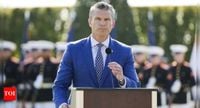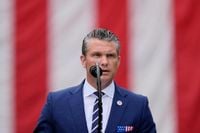Hundreds of the United States’ highest-ranking military officers are packing their bags and bracing for a journey to Quantico, Virginia, after receiving a surprise order from Defense Secretary Pete Hegseth. The directive, delivered with little notice and even less detail, requires nearly every general and admiral—about 800 in total—to report to Marine Corps University on Tuesday, September 30, 2025. For many, the abrupt summons has upended schedules, sparked anxious speculation, and sent ripples of uncertainty through the Pentagon and across military bases worldwide.
According to The Washington Post, the message was clear but cryptic: attendance was mandatory, and exceptions would be granted only in rare cases with top-level approval. The suddenness of the order caught even seasoned commanders off guard. Officers stationed in Europe scrambled for transatlantic flights, while those in the Pacific faced grueling travel to make the deadline. The usual military precision that governs such events seemed notably absent, replaced by a sense of urgency and mystery.
Behind closed Pentagon doors, staffers whispered about what some have dubbed a “military makeover.” Hegseth, a former Army officer and Fox News host, has been vocal about his desire to reshape not just policies but the very soul of the armed forces. His vision? Transforming the Department of Defense into the “Department of War,” with an emphasis on what he calls a renewed “warrior ethos.” According to CNN, the event is expected to resemble a “pep rally,” designed to energize senior leaders and, as one official put it, “get our fighters excited” about the administration’s new direction.
Yet, the vague agenda has left many wondering what really awaits them in Virginia. “It’s meant to be an eyeball-to-eyeball kind of conversation,” one person familiar with the planning told The Washington Post. “He wants to see the generals.” The decision to film the proceedings and turn what might have been a private military discussion into a public showcase has only heightened the pressure. Officers realize their reactions could become part of a broader political narrative about military transformation.
The timing of the meeting is especially sensitive. September 30 marks the end of the fiscal year, and a potential government shutdown looms. Meanwhile, U.S. forces are engaged in crises in Ukraine, Gaza, and the Middle East, making the absence of so many top commanders a logistical headache—and, some argue, a security risk. Senator Tammy Duckworth has circulated a letter warning of the costs, security risks, and operational disruptions posed by bringing hundreds of top officers stateside simultaneously. “It does have an impact, pulling them all in. Why is it so important to get them all in the room?” one U.S. official wondered aloud to The Washington Post.
Career anxieties are running high among senior officers. Over recent months, more than a dozen high-ranking officials have been dismissed following Hegseth’s directive to reduce flag officer positions by 20%. That means fewer four-star slots, fewer pathways to the Pentagon’s most prestigious roles, and a competitive atmosphere where even seasoned officers feel their futures hanging in the balance. According to CNN, many of those dismissed have been women and people of color, a fact that has not gone unnoticed in military circles and has drawn criticism from both within and outside the institution.
For military families, these changes represent more than just career adjustments. Spouses worry about sudden relocations, children face potential school changes, and retirement plans get thrown into disarray. The human cost of institutional transformation often goes unseen, but it weighs heavily on those living through it. “A showcase for Hegseth to tell them: get on board, or potentially have your career shortened,” a defense official told CNN, summing up the climate of uncertainty that now pervades the upper ranks.
The Pentagon has tried to maintain formal protocols, briefing relevant congressional committees about the upcoming gathering. According to The New York Times, the secretary plans to use the forum to outline new military fitness standards and other priorities. Tuesday’s session is just the first of three planned leadership addresses; follow-up lectures will focus on defense industrial base issues and deterrence strategies, suggesting a comprehensive communication campaign across multiple policy fronts.
Still, the unprecedented nature of the assembly has prompted heated debate among military analysts and veteran observers. Retired Lt. Gen. Ben Hodges went so far as to compare the gathering to a 1935 Nazi-era oath ceremony in Germany, prompting Hegseth to retort sarcastically on social media, “Cool story, General.” Retired Lt. Gen. Mark Hertling, speaking on MSNBC’s “Deadline: White House,” described the meeting as a “bright red light”—an indicator to allies and adversaries alike that something is amiss within the U.S. military. “That damages our image on the world stage,” Hertling warned, echoing concerns that the event could broadcast instability at a time when global confidence in American military leadership is already under strain.
The context for this gathering is a Pentagon in flux. Since taking office in January 2025, Hegseth has overseen a series of controversial decisions. The Defense Department recently restricted journalists from gathering even unclassified information without government approval, shuttered a committee dedicated to expanding women’s roles in the military, and faced criticism for allegedly sharing sensitive information on an unsecured messaging app. Each move has fueled a sense of chaos, leaving many to question the administration’s motives and methods.
Within the ranks, reactions to the renewed focus on “warrior ethos” and a “return to lethality” are mixed. Combat veterans may nod in approval at the emphasis on fighting spirit, but others—especially those in support roles—wonder if their contributions are still valued in this new paradigm. These conversations, often held in mess halls and barracks away from official channels, reflect the uncertainty and apprehension that now define daily life for many service members.
Vice President JD Vance has sought to downplay the controversy, calling the event “not particularly unusual.” But for many inside and outside the military, the scale, timing, and secrecy of the meeting stand out as anything but routine. The lack of communication within Defense Department divisions has only added to the confusion. As one Pentagon employee told HuffPost, “First he’d heard of it,” when asked about the meeting by an aide to a high-level military leader.
As the date approaches, the world watches closely. Allies and adversaries alike are left to interpret what this unprecedented gathering signals about the future of U.S. military leadership. For now, hundreds of generals and admirals are left to pack their uniforms, book last-minute flights, and wonder what message they’ll carry home from Quantico. Whatever happens on Tuesday, it’s clear this is a moment of reckoning—one that could reshape not only the Pentagon’s hierarchy but the very identity of America’s armed forces.



